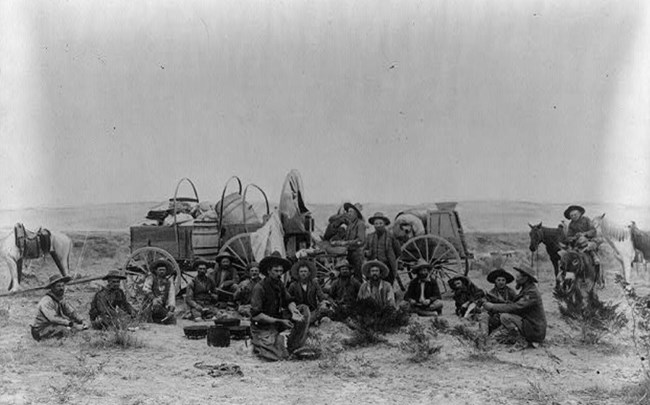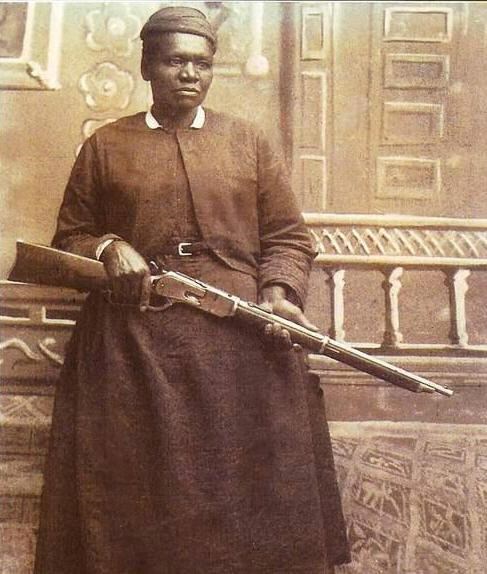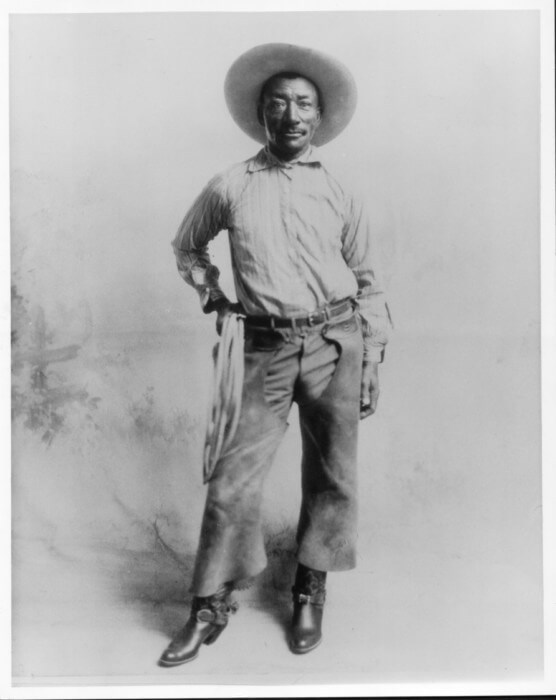Part of a series of articles titled Curiosity Kit: Black Cowpokes in the American West .
Previous: Engaging with Cowpoke History
Next: Places of Black Cowpokes
Article
The content for this article was researched and written by Dr. Katherine Crawford-Lackey.
With the growing demand for beef in the mid-to-late 1800s, cattle herding became a lucrative business. Cattle ranchers in western states hired cowboys to guide cattle to railroad depots where the animals were then shipped to eastern markets. Not only did cowboying become a way to make decent money, it was also a way for Black cowpoke to escape the racial discrimination of the South. Many formerly enslaved Black cowboys and cowgirls, such Bose Ikard and Mary Fields, found greater freedom in the west. While they were not fully free from discrimination and still faced the dangers of their work, their stories give us inspiration and perspective on what life was like in the “wild west.” Explore some of their stories below.

Opening Questions:
His story:
Much of Bose Ikard’s life is shrouded in mystery. Primary sources indicate that he was a well-known cowboy and ranch hand from Texas. Relying on oral interviews and census records, historians have pieced together parts of his story, including his adventures on the Goodnight-Loving Trail.
We know that Bose Ikard was born enslaved to the Ikard family sometime in the 1840s or early 1850s. There is little information about his immediate family. Oral accounts from relatives and friends indicate that Ikard was the son of an enslaved women and her enslaver, Milton Ikard. Around 1852, Milton Ikard, his family, and several enslaved people moved to Texas. While there are discrepancies in the historical record, it’s likely Bose Ikard was born in Mississippi and was forced to relocate to Texas when his enslavers purchased a ranch in Parker County. Growing up enslaved on the Texas ranch, Bose Ikard became a skilled farmer and cattle herder.
Freed after the Civil War, Ikard used his knowledge and skills to guide cattle along the Goodnight-Loving Trail. Beginning in the 1860s, white cowboys Charles Goodnight and Oliver Loving forged a partnership to herd cattle from ranches across Texas to western slaughterhouses and rail depots connecting the region to the eastern markets. With the help of Bose Ikard, Goodnight and Loving guided Texas Longhorns from Fort Belknap, Texas to Fort Sumner, New Mexico. Built in the mid-1800s, these two forts are now listed on the National Register of Historic Places. Over the next several years, Ikard continued to work with Goodnight as a tracker, wrangler, and as personal security.
While working on the Goodnight-Loving Trail, Ikard married a formerly enslaved woman named Angeline and together they had six children. In the following years, Ikard considered purchasing property in Colorado, but Goodnight convinced him to stay in Texas. Ikard purchased a farm in Weatherford, Texas and retired from cowboying. He died in 1928 or 1929 of influenza. Goodnight dedicated a monument to Ikard that reads:
“Bose Ikard served with me four years on the Goodnight-Loving Trail, never shirked a duty or disobeyed an order, rode with me in many stampedes, participated in three engagements with Comanches, splendid behavior.”

Public Domain, https://commons.wikimedia.org/w/index.php?curi
Opening Questions:
Her Story:
Born enslaved in Tennessee in the early 1830s, Mary Fields lived in bondage until the end of the Civil War. After emancipation, she traveled around the southern United States, finding work on steamboats along the Mississippi River. Fields eventually made her way to a convent in Toledo, Ohio where she managed daily operations, including washing laundry and maintaining the garden and grounds.
In 1885, Fields moved to St. Peter’s Mission, now a National Register listing, located in rural Montana. She joined several of the Toledo nuns who ran a school for American Indian girls. Fields cultivated the mission’s large garden and hunted game, ensuring that all staff and students were fed. Her labor was important in making sure life at the Mission ran smoothly. But when rumors spread that she was involved in a duel, Fields was banned from the Mission.
Forced from her home at St. Peter’s, Mary Fields moved to the nearby town of Cascade where she eventually obtained a contract to be a Star Route Carrier. Star Route Carriers were independent contractors who used a stagecoach to deliver the mail for the US Post Office. She delivered her route from St. Peter’s Mission to the town of Cascade from 1895 to 1903 without missing a day of work. Traversing the harsh weather of northern Montana, Fields encountered bandits and wolves. When the snow was too deep to drive the stagecoach, she trekked the route with snowshoes, delivering the mail on foot.
Mary Fields was the first African American woman and the second woman to receive a Star Route contract from the United States Post Office Department. (The first woman Star Route Carrier was Polly Martin, who drove a mail wagon from about 1860 to 1876 from Attleboro to South Attleboro, Massachusetts.) Fields died in 1914 and is buried in Cascade.

Opening Questions:
His Story:
Born in Texas around 1870, Bill Pickett learned the importance of being a skilled cattle wrangler from a young age. His parents were formerly enslaved and worked odd jobs to support Pickett and his 12 siblings. Around the age of ten, Pickett dropped out of school and worked as a ranch hand. He learned the tricks of the trade and even created a few of his own. The young cattle wrangler became known for developing the “bulldogging” technique which entails wrestling the steer to the ground. His technique was unique, and he became known for biting (yes, biting) the bull on the mouth to make it submit.
While cowboying started as a way for Pickett to earn a living, he soon became famous for his tricks. In the late 1890s and early 1900s, he performed in shows across Texas. He became famous throughout the state, but some venues and ranch owners barred Pickett from participating at certain events because he was Black.
Pickett took a big step into show business in 1905 when he joined the 101 Ranch Wild West Show. Based from the Miller family ranch in Oklahoma, a National Register listing, the show featured legends such as Buffalo Bill and Lucille Mulhall. In 1907, the Miller brothers took the show on the road. Bill Pickett and his fellow cowboys and cowgirls performed across the country, including at Madison Square Garden in New York City. Toward the end of his career, Pickett starred in several films, including the silent western The Bull-Dogger.
Pickett eventually retired from performing. He continued to work with horses until his death in 1932. Bill Pickett was posthumously inducted into the Rodeo Hall of Fame in 1971.
Cowboying became popular in what is now the United States in the 1860s with the increased demand for beef. Cattle ranchers hired cowpokes to herd steer to train depots where the animals were then shipped across the country. A number of Black men and women found a sense of freedom in the west, and many Black cowpokes eventually retired from the job and purchased property and established towns on the frontier. We can still see their legacies on the landscape today in sites such as Nicodemus in Kansas.
How was cowboying a way for people to seek freedom?
Who else do you think sought freedom out West? Why?
Part of a series of articles titled Curiosity Kit: Black Cowpokes in the American West .
Previous: Engaging with Cowpoke History
Next: Places of Black Cowpokes
Last updated: August 6, 2021